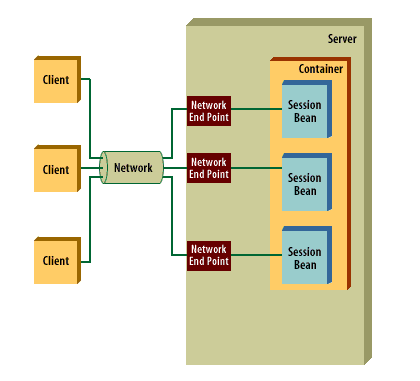| Lesson 5 | Session beans |
| Objective | Difference between stateless and stateful Session beans |
Difference between stateless and stateful Session Beans
Session bean description
A Session bean, whether stateful or stateless, is best understood by looking at its characteristics.
Look at the diagram below and then examine the list of characteristics:
Look at the diagram below and then examine the list of characteristics:
- A client can communicate to an EJBOjbect by means of 1) RMI, 2) Corba, 3) COM
- A session bean is created on behalf of a single client
- A session bean must implement the Session Bean interface
- The client uses a naming service to locate the session bean

- Executes on behalf of a single client. There is a one-to-one relationship between the client and the bean instance. In the diagram above, each client is associated with a single bean.
- Can have a transaction associated with it.
- May update shared data in an underlying database, but it does not directly represent the shared data.
- Is relatively short-lived. How long is short-lived, you may well ask? The EJB specification defines it as a fraction of a second to as much as a few months. It assumes that it does get removed (remove is equivalent to delete) at some point after its creation.
- Is removed when the container crashes. The state of the bean instance will be lost. The client will have to re-establish a new session bean instance to continue computation.
In the next lesson, stateful and stateless session beans will be discussed.